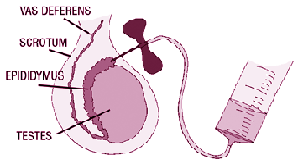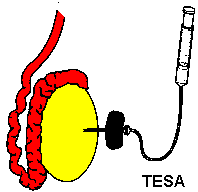Surgical Sperm Retrieval (PESA and TESA)
Surgical sperm retrieval is a technique for
collecting sperm from the vas deferens, epididymis or testis. This is a minor procedure, usually carried as a
day case surgery under a local or a general anesthetic.
Indication:
There are selected groups of patients to whom surgical sperm retrieval is recommended.
There are two methods of retrieving sperm surgically.

PESA (percutaneous sperm aspiration)
This is the first choice (if possible) to collect sperm. A fine needle is inserted through the scrotum into the epididymis and sperm are obtained by gentle suction. After each sample is collected, it is examined under the microscope to confirm the presence of sperm.
TESA (testicular sperm extraction)

A fine needle is inserted into the testis and sample of tissue are obtained by gentle suction and examined under the microscope. If sperm are not found, a small tissue sample (testicular biopsy) is taken through a small incision in the scrotum and testis, sperm can then be extracted from the tissue. The cut is stitched back together with a couple of stitches, which self dissolve in about 10 days. Finding sperm in the testicular tissue can be a laborious process. Surgically retrieved sperm are immature and incapable of fertilization by conventional means. Fertilization is achieved using ICSI, this involve injecting a selected sperm into the cytoplasm of a mature egg.
After the operation, you may feel discomfort, bruising and tenderness of the scrotum for 24-48 hours. This
will be relieved with painkillers such as paracetemol or codeine tablets. There is a small risk of infection
and bleeding after the procedure. A firm scrotal support is recommended until the discomfort subsides. The
long-term effects of repeated testicular biopsy are poorly understood.
Any spare sperm or testicular
tissues may be frozen for later use, thus avoiding a repeat of surgical sperm retrieval procedure.
